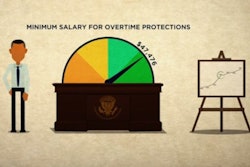
The Fair Labor Standards Act (FLSA) was created almost 80 years ago to establish a minimum wage, a 40-hour work week and to prohibit child labor. Most recently, the FLSA increased the salary threshold around who is eligible for overtime pay, which will be enforced on December 1. Under the new rule, employees exempt from overtime pay need to earn $47,476, more than double the current salary threshold of $23,600.
For the construction industry, which employs over 6.6. million people across the country, the rules however are not so explicit. Unlike other industries, construction has a unique blend of salaried employees, hourly workers and independent contractors, and the FLSA’s changes are structured differently towards each group.
Leading construction industry groups have been highly critical about the impending rule. The National Association of Home Builders and the Associated Builders and Contractors have voiced strong concerns, stating that it could encourage companies to reduce hours and benefits — thereby having the exact opposite of the new rule’s intent. On the flip side, the new rule is estimated to impact more than 110,000 construction supervisors, helping to bolster workers’ wages over the next decade.
Before you review workers’ salaries and wages to assess whether they are exempt or non-exempt from overtime pay, you should first check if your business is subject to the FLSA. The Department of Labor states that those who meet FLSA conditions “must have two or more employees and have an annual gross sales volume of $500,000.”
Even then there are exceptions. Any person who “works on or otherwise handles goods that are moving in interstate commerce or who works on the expansion of existing facilities of commerce is individually subject to the protection of the FLSA and the current minimum wage and overtime pay requirements, regardless of the sales volume of the employer.”
Get Answers to Your Questions About New Worker Overtime Rules
Moreover, blue-collar workers including carpenters, electricians, mechanics, non-management construction workers and laborers are always entitled to overtime pay.
This leaves you to review the employees who do not fall under the above group. Determining whether that employee is exempt from overtime pay depends on the individual’s salary threshold and that person’s primary duties.
For example, a salaried foreman who regularly supervises at least two full-time employees and conducts typical management responsibilities (such as hiring, planning work shifts, setting hours, etc), could be eligible for overtime pay, if he/she earns less than $47,476 per year.
For construction businesses, there are several options when it comes to reviewing overtime pay. These considerations include:
- Pay nonexempt employees time-and-a-half for overtime work. It may be the easiest option to simply pay workers the overtime rate once they have exceeded 40 hours in a workweek. It’s also important to assess and clarify if employees will be compensated for time worked before and after shifts and during meal breaks.
- Limit the number of hours worked per week. In this scenario, you’ll need to be very stringent in monitoring and ensuring that employees do not work longer than 40 hours per workweek. While this may seem like the most cost effective solution, it can be difficult to enforce. With an estimated 200,000 unfilled construction jobs in the country — up 81% in the last two years — working overtime hours to get the job done may be inevitable.
- Increase pay for workers just below the salary threshold. If an employee is making less than $47,476 per year (or $913 per week), it may make sense to give them a pay bump so that they are exempt from the new overtime rules. Any salary increases need to be managed and communicated carefully so that the employee does not feel they were inadequately compensated prior to the rule taking effect.
- Some combination of the above three options. For many businesses, identifying the right approach to remain compliant with the new overtime rule will equate to a blend of pay rises, overtime pay and work hour limitations. Ultimately, this best path depends on each employee, his or her job responsibilities and location.
For many companies, ensuring compliance to the new overtime rule means investing in the right advice upfront. After reviewing how the rule will affect your business, it’s prudent to consult with human resources, accounting and legal consultants to determine what measures to take in the short- and long-term, particularly as the new rule allows for automatic increases every three years.
Maintaining wage and hour compliance also centers around investing in the right time tracking solution.
At the core, all hours worked — including clarification on how time is logged for meal breaks, travel to and from shop to worksites and back, comp time, and segregating hours on a workweek basis when employees are paid bi-weekly — must be logged correctly.
Fortunately, technologies today have advanced beyond dated, paper-based systems. Rather, workers can download time tracking applications to capture hours worked in real-time, and these apps also utilize a smartphone’s GPS functionalities to remind workers to punch in and out of a shift as they are entering or leaving a jobsite.
Additionally, systems can monitor hours in real-time, providing alerts at preconfigured thresholds so that supervisors can manage employee hours and schedules accordingly.
Whatever the impact of the new rule to the construction industry, one thing is for certain — compliance can be challenging if you don’t take the time to review the rules. Thoroughly assessing your business, conducting a wage-and-hour analysis, and investing in the right advice and technologies can ultimately save you a lot of time and money against costly and damaging noncompliance lawsuits in the future.
Bob Drainville is the President of Timesheet Mobile, a time tracking solution that utilizes geofencing and GPS location technologies. The system is available as a smartphone application or as an integrated voice response (IVR) system, used by thousands of employees and contractors worldwide in industries including construction, healthcare, janitorial services and others with a significant mobile workforce.



















